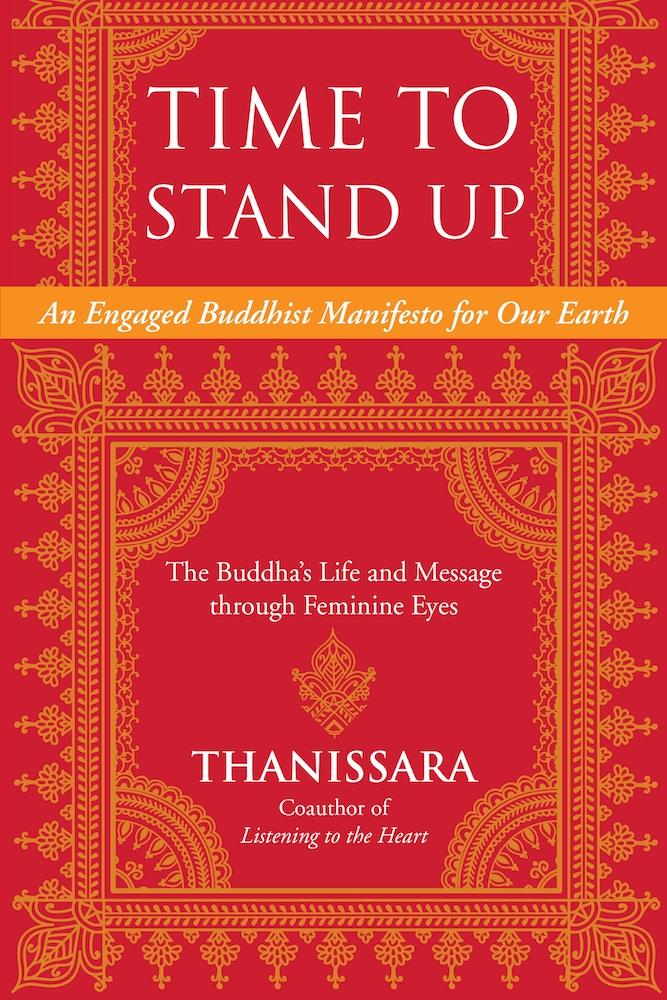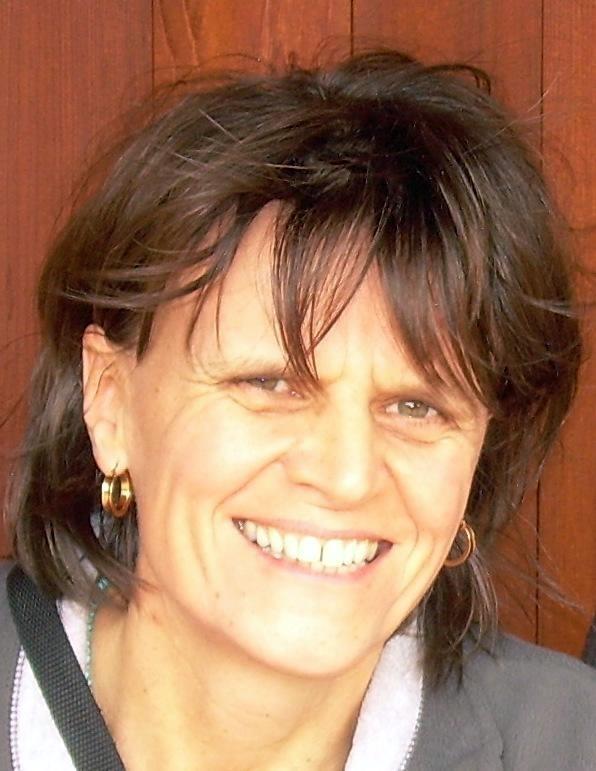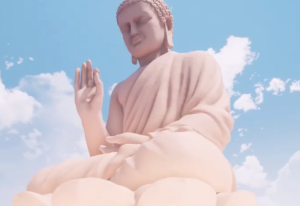A few chapters into the newly published Time to Stand Up, I joined the Sierra Club, one of America’s largest and oldest environmental groups. About halfway through reading, my partner and I recommitted to a vegetarian diet. Fair warning: this is not a book that will let you continue as you were doing before. For exactly that reason, it is worth reading.
Time to Stand Up is an exhortation, a vision, and a kick in the pants. Part of the “Sacred Activism Series” from North Atlantic Books, the book challenges its readers to face the inherent individualism in modern Buddhism; to transform that individualism into a new paradigm of relationship and community; and to apply that transformation to stopping climate change. Swinging the sword of her clear, pure anger and compassion, author Thanissara emulates Vajrayogini, the fierce feminine ideal: Get off your butt. Start acting like a real Buddhist. Take action.
Service is central to Thanissara’s own practice. A Western Buddhist, she was a monastic for many years and now works with AIDS patients in South Africa. Disconnection from the Earth has caused myriad problems, she says, from war and poverty to institutional discrimination. Among these many pressing concerns, her main focus for action is the environment, and specifically climate change. An increase in the world temperature by two degrees Celsius will cause “horrific consequences,” she writes, “but after that . . . we enter a serious tipping point of three to four degrees, at which time New York goes underwater, coral reefs completely die, and Italy, Spain, and Greece become desert-like. If we rise to over five to six degrees, then we’re looking at extinction.”
For Thanissara, the potentially irreversible harm we are doing to the Earth—and ultimately ourselves—is tied into a vast net of actions and reactions, interlocking structures, and misunderstandings of our place in the world. We are in need of a large-scale paradigm shift to save ourselves. She explains this shift as one from the masculine, which is individual, hierarchical, and goal-oriented, to a more relational and compassionate, feminine ideal. Rather than attempting to transcend the world in search of some private escape in nirvana, practitioners should focus on transforming it in order to nurture, sustain, and support the bonds that tie us to each other.
For that reason, Thanissara does not hesitate to critique the self-congratulatory, individualized “mindfulness Buddhism” of the West. Western Buddhists love to talk about our own psychological journeys, but how much does the intention to do good—to live in a compassionate and aware way—actually translate into service? Thanissara is not shy in her answer: “We [Western Buddhists] are being awakened into the realization that our special, personal enlightenment trek and our small, tribal Sangha endeavors are not going to inspire the kind of ‘game changer’ needed for collective transformation,” she writes. “. . . If we just sit this out, our ‘equanimity’ will become indifference, our focus on personal awakening will be revealed as self-absorption, and our seeking of peaceful, mindful moments will become willful avoidance and denial.” Her unsparing words are accompanied by a conviction that Buddhist practitioners can move beyond mere personal awakening to a more holistic view.
Thanissara calls on Buddhists to see the Earth as more than a place to escape. In addition, she encourages practitioners to address their tendency to label: me and you, male and female, powerful and powerless. For Thanissara, this rigid “male” dualism is not only antithetical to the Buddha’s original message of interconnectedness; it is also the cause of war, injustice, and environmental degradation. “The moment we create an ‘us’ and ‘them,’ we contribute to the underlying divisions that generate climate crisis, which ultimately is a crisis of consciousness,” she writes. In other words, addressing our dualistic worldview is the first step to addressing climate change.
Similarly, the lack of feminine perspective is harmful to Buddhism itself. In most lineages, nuns are not permitted to receive full ordination, a point that hits home for Thanissara. She recalls a male teacher who told her women weren’t capable of achieving the same insight as men: “Basically, as they would say in the British army, we weren’t up to muster. This was a men’s club, and they would make the rules, and those rules would always keep us women in an ambivalent, disempowered, and dependent state.” Her own Thai Forest School experienced catastrophic upheaval when nuns began to ask for full ordination; many women left the order, disillusioned and unhappy, when told they would always be subordinate. Reclaiming feminine wisdom is an institutional necessity, she says.
There are times when Thanissara’s arguments stray into broad generalizations. The male and female principles—which can be embodied in any gender—aren’t always delineated from the experience of real, gendered men and women. At times, she sweeps over huge topics swiftly, covering in the space of five pages Margaret Thatcher, Aung San Suu Kyi, Monsanto and farmer suicides in India, the Trans-Pacific Partnership, and medical experimentation on animals. While she writes with passion, she doesn’t carefully connect disparate and complex topics. A passage on how exiting the birth canal causes our first dualistic trauma—leading to the Holocaust, supposedly—was farfetched and unconvincing.
But her storytelling of Siddhartha Gautama’s journey to awakening hits home. She weaves his mythical, historical, and archetypal journey throughout the text, using it to point out inconsistencies in modern Buddhism and guide us toward a more equitable, compassionate practice. In a sense, she advocates a return to the core principles of Buddhism: a true sangha, working together for the good of all beings.
Time to Stand Up is profoundly jarring and also profoundly idealistic. Too often, we are satisfied with our personal contemplative experiences, she writes. But contemplation is not enough for a Buddhist practitioner; personal awakening must be the beginning, not the end, of practice. Time to Stand Up urges us to move further out of our individual selves, into our larger, interconnected self. Shifts in consciousness at the personal, monastic, and societal level will result in the kind of engaged Buddhism that just might save the world. After all, she says, “What value is all this meditation and mindfulness if we just sit by and let the world burn?”













